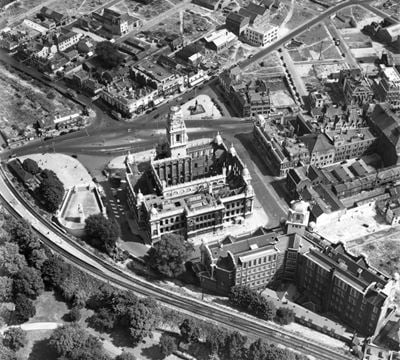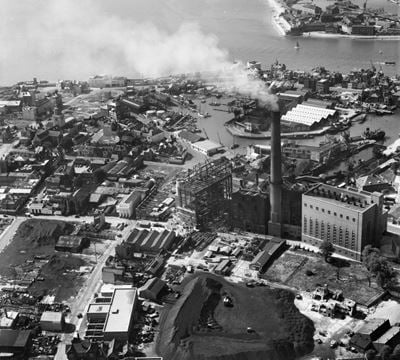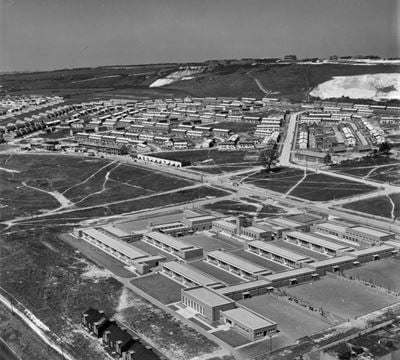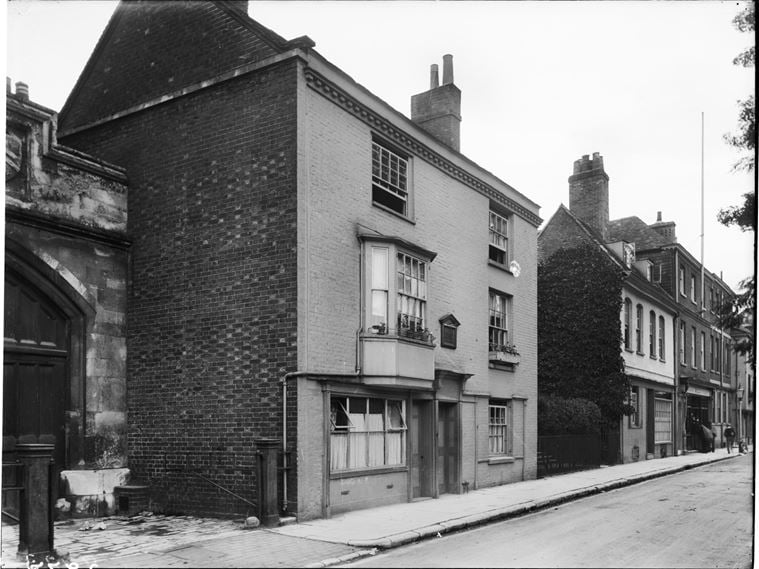Portsmouth
Explore hidden histories, historic photos, and things you never knew about Portsmouth from the collections and archives of Historic England.
Discover your local listed buildings and places
Introducing some of Portsmouth's most historic sites, included in the National Heritage List for England. Some of these captions have been summarised by AI. Click through for the official List entry. Skip this section and go to place by numbers
Former IBM Pilot Head Office (now Lynx House)
Portsmouth
Office building, 1970-71 by Foster Associates; structural engineers Anthony Hunt.
Southsea Common
Portsmouth
Southsea Common, developed from waste ground, became a 19th-century pleasure ground in Portsmouth, featuring forts, gardens, memorials, and parks, retaining historical significance through...
Long Curtain, King's Bastion and Spur Redoubt
Portsmouth
Portsmouth's 17th-century defences, designed by Sir Bernard de Gomme, include the Long Curtain wall and the King's Bastion, with the unique Spur Redoubt enhancing its strategic strength.
Hilsea Lines
Portsmouth
Linear bastioned and casemated defensive fortification, built between 1858 and 1871, replacing C18 defences protecting the northern approach to Portsmouth.
Mary Rose
Spithead, off Portsmouth
The Mary Rose, Henry VIII's flagship, sank in 1545. Raised remains from 1982 and parts recovered in 2005 are displayed by the Mary Rose Trust; the rest is protected underwater.
HMS Invincible
Horse and Dean Sand, Eastern Solent, off Portsmouth
HMS Invincible, a British Third Rate ship, stranded and capsized in 1758. Originally French, she played a crucial role in naval design history.
Spitbank Fort
City of Portsmouth
Spitbank Fort, a 19th-century sea fort, forms part of Britain’s coastal defence system in the Solent, showcasing its strategic importance against maritime threats.
Former Her Majesty's Prison Kingston
Portsmouth
The former HMP Kingston, Portsmouth, includes the principal prison building, executed in a robust, polychromatic, idiom; the boundary wall; and the entrance complex (comprising gate tower,...
Fort Cumberland
Portsmouth
Fort Cumberland, an 18th-century bastioned fort, showcases Portsmouth's extensive historical defense network, offering significant insights into England's military architectural evolution.
Horse Sand Fort
City of Portsmouth
Horse Sand Fort, built in the late 19th century, is a significant maritime defense structure designed to protect Portsmouth dockyard and is part of Palmerston's follies.
38 Kent Road and 3-15 (consec) Portland Terrace, Southsea…
Portsmouth
A terrace of 13 houses converted into flats c1978 and a former hotel, all built in 1846-49 by the architect builder and developer TE Owen.
The Kings Theatre, with numbers 24-28 (even) Albert Road,…
Portsmouth
Theatre, 1906-1907, designed by Frank Matcham for John W Boughton of the Portsmouth Theatres Company; the builder was Frank Corke.
Kingston Cemetery
Portsmouth
A Burial Board cemetery with buildings designed by the architect George Rake and grounds laid out under the supervision of the Board surveyor Charles B Smith, which opened at the beginning...
Queen's Hotel, Southsea
Portsmouth
The Queen's Hotel, Southsea, built in 1903-1904 (dated 1903) to the designs of Thomas William Cutler in Free Baroque style, with sculpture by Frederick E E Schenck.
Portsmouth Naval War Memorial
City of Portsmouth
The Naval Memorial at Portsmouth, standing on Southsea Common, overlooking the promenade, and the sea beyond.
Victoria Park
Portsmouth
Victoria Park, established in 1878 on former defensive lands, features monuments honoring Portsmouth’s naval history and a historical avenue from the 19th century.
No Man's Land Fort
Nettlestone and Seaview
No Man's Land Fort, part of Britain's 19th-century coastal defences, exemplifies strategic maritime fortifications built in response to the French Navy threat post-1859.
City of Portsmouth War Memorial
Portsmouth
The City of Portsmouth War Memorial, unveiled in 1921, designed by J S Gibson and W S A Gordon, with sculpture by C S Jagger; the builder was Samuel Salter.
Lamp columns on Eastney Esplanade
Portsmouth
Lamp columns. Erected in about the early C20 probably by Drew-Bear, Ransome and Perks, Engineers, London.
Landport Gate
Portsmouth
Landport Gate, attributed to Nicholas Hawksmoor, is the only Portsmouth gateway on its original site, serving as the main entrance prior to 1875 fortification demolition.
Lamp columns on esplanade, east of Southsea Castle
Portsmouth
Lamp columns. Erected in around the early C20 probably by Drew-Bear, Ransome and Perks, Engineers, London.
Lamp columns to esplanade, east of South Parade Pier
Portsmouth
Lamp columns. Erected in around the early C20 probably by Drew-Bear, Ransome and Perks, Engineers, London.
Three lamp columns to esplanade, west of South Parade Pier
Portsmouth
Lamp columns. Erected in around the early C20 probably by Drew-Bear, Ransome and Perks, Engineers, London.
Church of St James
Portsmouth
Anglican churchBuilt 1911-13 to the design of John Oldrid Scott & Son.
Block Mill and Numbers 35 and 36 Stores (Building Number …
Portsmouth
Block Mill was built between 1799-1806 for mass production with steam-powered tools, featuring machinery by Brunel and Maudslay, marking a significant naval industrial innovation.
Explore more
Search for more listed placesPortsmouth through time
This timeline shows the first period of use for buildings and places on the National Heritage List for England, just one of the details recorded for every list entry. Click around to see how Portsmouth changes over time. Skip this section and go to aerial photos
Medieval AD 1066 to AD 1540
This period, sometimes known as the Middle Ages, began with the Norman invasion in AD 1066. It saw a significant rise in military and defensive buildings such as castles and earthworks, as well as religious houses dominating a largely agricultural landscape.
The monarchy and Church dominated the period, which also saw the break with the Roman Catholic Church and the English reformation.
Post medieval AD 1540 to AD 1901
The Post-Medieval period brought seismic changes to life in England, with religious reformation leading to the democratization of worship and the destruction of hundreds of religious houses.
In parallel, there was a huge expansion of scientific study and enlightenment that permanently altered the nation's social structure and landscape. Industrialization and mass production lead to wider global trade, emigration, and immigration.
20th century AD 1901 to AD 2000
The 20th century saw an incredible expansion of England's transport networks, with suburban growth shadowing rapid infrastructural expansion. The establishment of state schools, hospitals, and modern technical colleges, with new architectural styles, radically changed the appearance of towns and cities.
Two catastrophic world wars and the 1918 pandemic also brought unprecedented change, altering England's built environment and social structures forever.
Medieval AD 1066 to AD 1540
This period, sometimes known as the Middle Ages, began with the Norman invasion in AD 1066. It saw a significant rise in military and defensive buildings such as castles and earthworks, as well as religious houses dominating a largely agricultural landscape.
The monarchy and Church dominated the period, which also saw the break with the Roman Catholic Church and the English reformation.
Post medieval AD 1540 to AD 1901
The Post-Medieval period brought seismic changes to life in England, with religious reformation leading to the democratization of worship and the destruction of hundreds of religious houses.
In parallel, there was a huge expansion of scientific study and enlightenment that permanently altered the nation's social structure and landscape. Industrialization and mass production lead to wider global trade, emigration, and immigration.
20th century AD 1901 to AD 2000
The 20th century saw an incredible expansion of England's transport networks, with suburban growth shadowing rapid infrastructural expansion. The establishment of state schools, hospitals, and modern technical colleges, with new architectural styles, radically changed the appearance of towns and cities.
Two catastrophic world wars and the 1918 pandemic also brought unprecedented change, altering England's built environment and social structures forever.
Aerial photos of Portsmouth
Aerial photography helps reveal secrets of England's changing landscapes that are impossible to see from the ground. Skip this section and go to archive images

Portsmouth
The city centre, Portsmouth, 1951

Portsmouth
The Guildhall and environs, Portsmouth, 1951

Anchorage Park
Portsmouth Aerodrome, Anchorage Park, 1932

Anchorage Park
Portsmouth Aerodrome and Hilsea Gas Works, Anchorage Park, 1932

Portsmouth
Warblington Street, the Power Station and Inner Camber, Portsmouth, 1950

Portsmouth
Portsmouth Power Station, Camber Dock and environs, Portsmouth, 1951

Anchorage Park
Hilsea Gas Works, Anchorage Park, 1949

Anchorage Park
Hilsea Gas Works, Portsmouth Airport and environs, Anchorage Park, 1949

Paulsgrove
Hillside Primary Schools and environs, Paulsgrove, 1951

Paulsgrove
Hillside Primary Schools, Paulsgrove, 1951
Portsmouth in the Historic England Archive
The Historic England Archive cares for over 15 million images, dating from the 1850s to the present day. Discover stunning images of Portsmouth's past. Skip this section and go to stories about heritage
Charles George Harper Collection
Ports Down Hill, City Of Portsmouth
Date created: 1892 - 1933
Two sailors outside the Belle Vue Tea Gardens, with a view down the London Road towards Portsmouth Harbour beyond
Eric de Mare
Portsmouth, City Of Portsmouth, City Of Portsmouth
Date created: 1956
General view of a figurehead from HMS Benbow outside Boat House number 5 at Portsmouth Naval Dockyard.
John Laing Collection
Cambridge Junction, City Of Portsmouth, City Of Portsmouth
Date created: 1946
View of services men and women in the canteen of the NAAFI Services Club in Portsmouth
Nigel Temple Collection of Postcards of Parks and Gardens
Southsea Common, City Of Portsmouth
Date created: 1920 - 1935
GENERAL VIEW SHOWING SOUTH PARADE PIER AND GARDENS
Eric de Mare
Portsmouth, City Of Portsmouth, City Of Portsmouth
Date created: 1956
Exterior elevation of the fire station at Portsmouth Naval Dockyard. The dockyard included a 'village' for senior officials.
John Laing Collection
Cambridge Junction, City Of Portsmouth, City Of Portsmouth
Date created: 1946
View of services men and women in the lounge of the NAAFI Services Club in Portsmouth
Nigel Temple Collection of Postcards of Parks and Gardens
Southsea Common, City Of Portsmouth
Date created: 1920 - 1935
GENERAL VIEW LOOKING TOWARDS SOUTHSEA CASTLE
Eric de Mare
Portsmouth, City Of Portsmouth, City Of Portsmouth
Date created: 1956
Exterior elevation of the fire station at Portsmouth Naval Dockyard showing the windows.
John Laing Collection
Cambridge Junction, City Of Portsmouth, City Of Portsmouth
Date created: 1946
View of the NAAFI Services Club in Portsmouth
Nigel Temple Collection of Postcards of Parks and Gardens
Southsea Common, City Of Portsmouth
Date created: 1930 - 1939
GENERAL VIEW OF WATERFALL
John Laing Collection
Cambridge Junction, City Of Portsmouth, City Of Portsmouth
Date created: 1946
View of services men and women in the bar of the NAAFI Services Club in Portsmouth
Nigel Temple Collection of Postcards of Parks and Gardens
Southsea Common, City Of Portsmouth
Date created: 1926 - 1931
GENERAL VIEW LOOKING ACROSS THE ROCK GARDENS TOWARDS THE SOUTH PARADE PIER
Stories about heritage in your local area
Historic England publishes news, blogs, research, videos, and podcasts celebrating England's rich heritage. Discover the stories we have about Portsmouth. Skip this section and go to education
If Street Furniture Could Talk
Mentions Bollard on South Side of Junction With Bathing Lane
Street furniture probably isn’t the first thing that comes to mind when you think of protected heritage.
10 Exceptional First World War Memorials
Mentions Portsmouth Naval War Memorial
These are some of the most outstanding memorials to those who died during the First World War.
Mentions Portsmouth
The Rooswijk was a Dutch East India Company trading ship that sunk in January 1740 on the Goodwin Sands off the Kent coast.
What We Found on a 1740 Shipwreck: Sabres, Silver and Secrets From the Deep
The Rooswijk was a Dutch East India Company trading ship that sunk in January 1740 on the Goodwin Sands off the Kent coast.
Historic England's Science Facility Reopens After Major Refit
Mentions Portsmouth
Historic England’s flagship science facility at Fort Cumberland in Portsmouth reopens after year-long refit, marking 75 years of specialist work.
The 'London' Wreck – Excavation and Analysis of Material at Risk
Mentions Portsmouth
Work on the 'London' wreck has revealed a wealth of information about this 17th-century warship.
Articulating Loss: Understanding and Communicating the Loss of Coastal Heritage
Mentions Portsmouth
A collaborative PhD project researching methods of communicating the physical and emotional impacts of loss of coastal heritage.
Rooswijk Shipwreck Excavation The Post Excavation Phase
Mentions Portsmouth
Find out how a team of specialists is researching and conserving the artefacts from the 18th-century shipwreck of the Rooswijk.
The London Wreck: A Kaleidoscope of Specialists, Materials and Artefacts
Mentions Portsmouth
Scientific analysis of the finds from the wreck of the London has revealed a wealth of information about life aboard a 17th century Royal Navy Vessel.
Browndown: Training for Trench Warfare in the First World War
Mentions Portsmouth
Recent survey has supported protection at one of the best preserved First World War training grounds.
Gosport: A Town Defined by its Military Heritage
Mentions Portsmouth
Gosport is a place whose character is defined by its military heritage and this is underpinning the town’s Heritage Action Zone and regeneration.
To Unpath’d Waters, Undream’d Shores
Mentions Portsmouth
The Unpath'd Waters project by Historic England aims to connect the UK’s marine and maritime heritage collections through partnership.
Shipwreck Linked To Wordsworth Family Granted Protection
Mentions Portsmouth
The wreck of the Earl of Abergavenny has been scheduled by DCMS on the advice of Historic England.
Research Reports Roundup to February 2024
Mentions Portsmouth
A roundup of new additions to the Historic England Research Reports database and a longer term overview of industrial heritage reports.
Protecting the Recent Past for the Future
Mentions Portsmouth
Researching and managing First World War submarine wrecks in English waters
Discovery Is Only The Beginning
Mentions Portsmouth
Examining how the application of multiple scientific analyses enhances our understanding of historic shipwrecks.
Portsmouth's social history through photos
Over 10,000 images from the Historic England Archive have been specially selected and re-captioned for teachers, students, and anyone who wants to learn more about their local area. Skip this section and go to grant-aided places
Wall painting in the church of St Agatha, Landport, Hampshire
Period: Victorian (1837 - 1901)
The church of St Agatha, Landport, was built in 1893-5. The apse was painted in 1901 by Heywood Sumner.
Wall painting in the church of St Agatha, Landport, Hampshire
Victoria Park, Edinburgh Road, Portsmouth, Hampshire
Period: Edwardian (1902 - 1913)
A public park laid out in 1878 by the County Borough of Portsmouth on the site of the town's former defences.
Trident Memorial, Portsmouth, Portsmouth
Period: Victorian (1837 - 1901)
This memorial was built in c1860. It has the inscription "To the memory of forty-four Officers and Men of H.M.S.
Trident Memorial, Portsmouth, Portsmouth
Treadmill at HMP Kingston, Portsmouth, Hampshire
Period: Victorian (1837 - 1901)
Kingston Prison opened in 1850. Like many prisons in the 19th century, HMP Kingston adopted the policy of hard labour on unproductive tasks.
Treadmill at HMP Kingston, Portsmouth, Hampshire
Trafalgar Monument, Portsmouth, Portsmouth
Period: Georgian (1714 - 1836)
This is the anchor from the ship H.M.S Victory. The inscription on the monuments says 'The Battle of Trafalgar.
Trafalgar Monument, Portsmouth, Portsmouth
The Square Tower, Portsmouth, Portsmouth
Period: Tudor (1485 - 1602)
The Square Tower was originally a fortification and Governor's residence. It was built in c1494.
The Square Tower, Portsmouth, Portsmouth
The Round Tower, Portsmouth, Portsmouth
Period: Medieval (Middle Ages) (1066 - 1484)
The Round Tower fortification is now museum. It was originally built in c1415. The ground floor was reconstructed in c1538-40.
The Round Tower, Portsmouth, Portsmouth
The Common, Southsea, Portsmouth, Hampshire
Period: 1920s (1920 - 1929)
This image, taken between 1919 and 1924, of Southsea Common was reproduced as a postcard.
The Common, Southsea, Portsmouth, Hampshire
Discover more
Ready for more local stories? Take a look at these other places nearby

Havant
Local Authority District

Fareham
Local Authority District

Winchester
Local Authority District